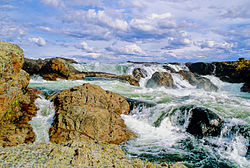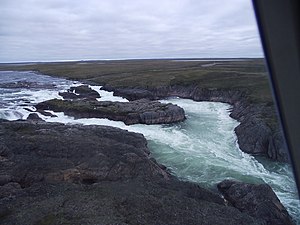geo.wikisort.org - River
The Kazan River (Inuktitut Harvaqtuuq,[3] Inuktitut syllabics ᓴᕐᕙᖅᑑᖅ;[4] meaning "strong rapids",[5] "the big drift"[3] or "place of much fast flowing water"[4]), is a Canadian Heritage River located in Nunavut, Canada. The Dene name for the river was Kasba-tue meaning "white partridge river." The name was apparently changed to Kazan in the late 19th century due to the influence of Order of Mary Immaculate missionaries.[6] The river headwaters are in northern Saskatchewan[7] at Kasba Lake, and it flows north for about 1000 km (621 mi)[7] before emptying into Baker Lake (64°09′00″N 95°30′00″W), on the opposite side of the mouth of the Thelon River. Along its course the river flows through several lakes, including Ennadai Lake and Yathkyed Lake, over the Kazan Falls (25 m (82 ft)), down a red sandstone gorge[7] and through both boreal forest and tundra. It is the last section of the river, below Ennadai Lake, that is above the timber line and is designated a Canadian Heritage River.
| Kazan River | |
|---|---|
 Kazan Falls, on the lower Kazan River, July 2004 | |
 Kazan River mouth location | |
| Location | |
| Country | Canada |
| Physical characteristics | |
| Source | Kasba Lake |
| • location | Northwest Territories |
| • coordinates | 60°34′22″N 102°08′47″W |
| Mouth | Baker Lake |
• location | near Chesterfield Inlet, Kivalliq Region, Nunavut |
• coordinates | 64°2′30″N 95°29′5″W |
| Length | 1,000 km (620 mi) |
| Basin size | 71,500 km2 (27,600 sq mi) |
| [1][2] | |
Fauna and flora
Although many species of wildlife may be observed along the river, it is the barren-ground caribou (Qamanirjuaq and Beverly herds) for which it is most well known. Over 300,000 caribou migrate through the area and it is said to be the largest migration of any land animal. Other wildlife that may be observed in the area include muskox, wolverine, peregrine falcon and many species of fish.
History


The abundance of wildlife along and close to the river attracted both the Caribou Inuit and the Chipewyan Sayisi Dene for about 5,000 years. Originally, the Caribou Inuit did not live in the area but returned to the coast for the winter. In the 18th century, Dene use of the area declined and Caribou Inuit, especially the Harvaqtuurmiut ("people of the Harvaqtuuq") and Ihalmiut bands, began to live along the river year round.[8] Remnants of Ihalmiut campsites, and those of the Dene may be found along the river. Although the Inuit today no longer live along the river, they do still travel it to hunt and fish.
The first European to visit the area was Samuel Hearne in 1770 at Yathkyed Lake. However, the river was not mapped until visited by Canadian geologist and cartographer Joseph Tyrrell in 1894. Explorer Knud Rasmussen also visited the area in 1921–1924 during the Fifth Thule Expedition.
Recreation
The river has also become a popular destination for kayaking and canoeists.[9]

See also
References
- "Natural Resources Canada-Canadian Geographical Names (Kazan River)". Retrieved 2014-08-29.
- "Atlas of Canada Toporama". Retrieved 2014-08-29.
- Harvaqtuurmiut : The Heritage of the Inuit of the Lower Kazan River
- Kitikmeot Heritage Centre
- Tuhaalruuqtut, Ancestral Sounds
- Sikstrom, C. B. (2012-12-10). "The Naming of Kazan River, Nunavut, Canada". Arctic. 65 (4): 433–438. doi:10.14430/arctic4241. ISSN 1923-1245. Archived from the original on 2018-06-02. Retrieved 2016-04-20.
- "Nunavut: Heritage Rivers" Archived 2013-01-21 at the Wayback Machine The Atlas of Canada
- Farley Mowat (2006). No Man's River. Da Capo Press. p. 24. ISBN 978-0-7867-1692-0.
- "Kazan River | Canadian Canoe Routes".
Further reading
- Keith, Darren. Inuit place names and land-use history on the Harvaqtuuq (Kazan River), Nunavut Territory. Thesis (M.A.)--McGill University, 2000, 2000. ISBN 0-612-64162-7
External links
На других языках
[de] Kazan River
Der Kazan River (Inuit-Sprache: Harvaqtuuq) ist ein Fluss in Nunavut (Kanada).- [en] Kazan River
[it] Kazan (fiume)
Il Kazan ("pernice bianca" in lingua inuit) è un fiume del Canada che scorre nel Nunavut. Il fiume nasce nei pressi del lago Obre e scorre in direzione nord per circa 850 km prima di gettarsi nel lago Baker e diventare quindi affluente del fiume Thelon. Attraversa taiga e tundra, e quando supera la linea-limite dei pini il suo corso entra a far parte del Canadian heritage. Questo fiume è noto sia per la pesca sportiva che per la pratica della canoa e del kayak.[ru] Казан (река)
Каза́н[1] (англ. Kazan River[2]) — река на северо-западе Канады (Северо-Западные территории, Нунавут[3]. Впадает в озеро Бейкер[1].Другой контент может иметь иную лицензию. Перед использованием материалов сайта WikiSort.org внимательно изучите правила лицензирования конкретных элементов наполнения сайта.
WikiSort.org - проект по пересортировке и дополнению контента Википедии